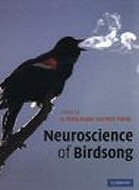|
Neuroscience of Birdsong
|
|
Edited by: H. Philip Zeigler and Peter Marler
|

|

Speech has long been thought of as a uniquely defining characteristic of humans. Yet song birds, like humans, communicate using learned signals (song, speech) that are acquired from their parents by a process of vocal imitation. Both song and speech begin as amorphous vocalizations (subsong, babble) that are gradually transformed into an individualized version of the parent’s speech, including dialects. With contributions from both the founding forefathers and younger researchers who represent the future of this field, this book provides a comprehensive summary of birdsong neurobiology, and identifies the common brain mechanisms underlying this achievement in both birds and humans. Written primarily for advanced graduates and researchers, there is an introductory overview covering song learning, the parallels between language and birdsong and the relationship between the brains of birds and those of mammals; subsequent sections deal with producing, processing, learning and recognizing song, as well as with hormonal and genomic mechanisms.
H. Philip Zeigler is Distinguished Professor of Psychology at Hunter College, City University of New York. He is a behavioral neurobiologist whose research has focused on neural and sensorimotor control of behavior patterns in birds and mammals
Peter Marler, Professor Emeritus at the University of California, Davis and Foreign Member of the Royal Society, is recognized as the founding father of birdsong research. He has authored numerous books and papers on animal behavior, and his research has set the major directions of the field, providing guidance to several generations of leading researchers.
|
|
